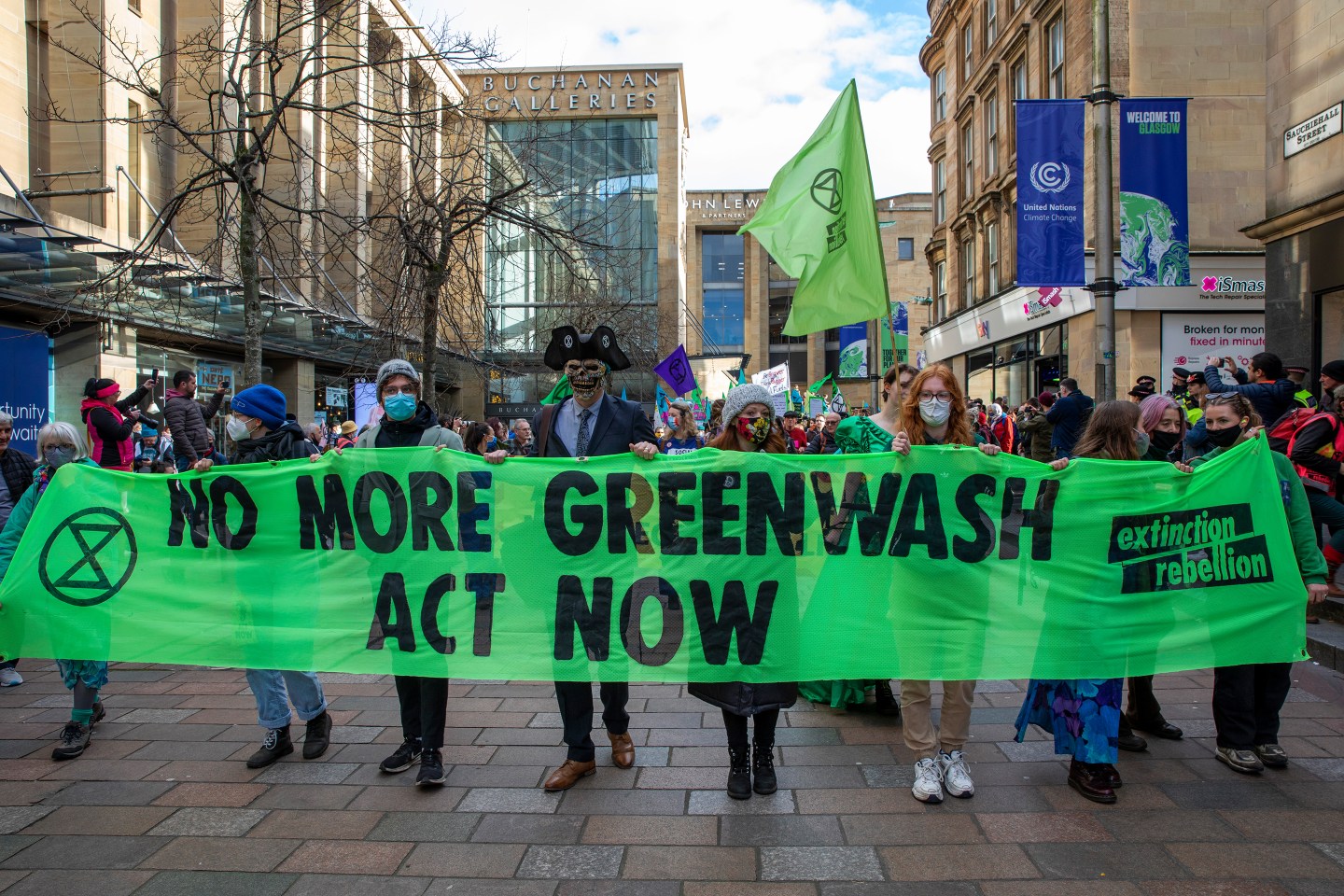Corporate greenwashing is an increasingly contentious topic around the globe. Now, European policymakers claim they are stepping up their fight against it.
Amid a record inflow of investments into European climate-friendly funds, the region’s top markets regulator, the European Securities and Markets Authority (ESMA), published a new road map last month, in which it identified tackling greenwashing as a priority for the next two years.
“The road map is a milestone for our sustainable finance work, identifying the priority work we will do to ensure that ESMA and national supervisors take ambitious action on priority sustainable finance issues,” said Verena Ross, chair of the watchdog, in a statement.
The new document aims to set a practical framework to eliminate greenwashing, and is the latest move to set Europe apart as a global leader in this space. The region has already committed to the goal of becoming the first climate-neutral continent by 2050.
But ESMA’s efforts won’t come without hurdles as, despite those efforts, the European sustainable finance landscape continues to be fragmented owing to a low degree of standardization and available data.
“On the surface, the road map is a step in the right direction,” says Will Wilson, ESG assistant vice president, climate lead at fund servicing firm Apex Group, noting that standardized reporting of sustainability data is essential for companies, investment managers, or private equity funds to meet any new or existing requirements.
“What needs to happen, though, is a far greater harmonization between everything,” he notes. “Until then, we won’t really achieve what these regulations have been designed to do, which is combat greenwashing.”
Besides addressing greenwashing, ESMA said it would promote transparency; build national competent authorities (NCAs) and its own capacities in the sustainable finance field; and assess environmental, social, and governance (ESG) claims to ensure they wouldn’t be misleading. To reach these objectives, the regulator plans to outline and introduce actions across several sectors from this year throughout 2024, including investment management, investment services, issuers’ disclosure and governance, benchmarks, credit and ESG ratings, trading and post-trading, and financial innovation. Additionally, it aims to help develop common methodologies for climate-related risk analysis along with other standard-setters.
Defining greenwashing
Before all that, however, ESMA will have to first define what greenwashing is, given there is no official legal description of what the practice means—just as there are no universally agreed upon definitions for “sustainable”, “green,” or “impact” investments.
“Investigating the complex issue, getting to defining its fundamental features and taking coordinated action to find common solutions is key to secure investor protection,” the road map reads. “There is now a real need to address greenwashing without delay, even if all the legislative stepping-stones are not fully in place yet.”
The road map, which ESMA has described as a “living document” and subject to periodical updates, is the latest effort from Europe to put together the world’s most ambitious green rule book for financial markets to date. It follows the release, in March of last year, of the Sustainable Finance Disclosure Regulation (SFDR), EU legislation that seeks to increase the transparency of sustainability claims and decrease the use of greenwashing by financial firms, with the goal to drive 1 trillion euros ($1.19 trillion) into green investments over the next decade. But its implementation has proved far from straightforward.
But it also follows the recent, highly controversial EU decision to include nuclear energy and fossil gas in its list of economic activities that can be classified as “green” investments under the EU Taxonomy Regulation—a unified classification system that’s been in place since July 2020 to identify economic activities that would qualify as environmentally sustainable. The plan was labeled as “the biggest exercise in greenwashing of all time” by environmental campaigners, casting doubt on the credibility of the union’s green aspirations.
Soaring greenwashing cases
Against this backdrop, the road map might help reset the sector’s transition toward more sustainable investment models across the board, by way of providing better intel for companies that want to meet their ESG targets.
ESMA’s intention to define greenwashing is certainly a positive first step in that direction. To date, there is no clear-cut framework against which firms can be held accountable, nor sanctions or penalty fees for those who make misleading environmental claims.
Meanwhile, as a direct consequence of investors’ growing appetite for sustainable finance, cases of greenwashing by asset managers have soared in recent years. A report published last year by London-based climate change think tank InfluenceMap on 723 equity funds that marketed themselves using ESG claims and climate-related keywords found that more than 70% of them were misaligned with global climate targets. But regulators have generally left them unpunished, partly because there are no hard rules around it.
The road map could possibly correct that.
“Everybody intuitively knows what greenwashing means,” says Derek Lawlor, an Ireland-based financial services regulatory partner at law firm Simmons & Simmons. “But I think it’s important that ESMA is now saying it will investigate examples of it in different sectors across member states, together with the NCAs, to really boil down what it actually is. Once we have that definition from a central supervisory authority, rolling out and taking action should be easier than it has been so far.”
Anne-Claire Imperiale, head of ESG and stewardship at Sycomore AM, an asset management company specializing in sustainable listed investments, concurs. “Having ESMA and the NCAs take ownership of what can and cannot be done is extremely important for the European development of a sustainable finance landscape,” she notes. “We certainly need some coherence.”
Yet that’s only half the battle. Better due diligence, a stronger focus on data, and a more strategic collective strategy, analysts say, will be key to ensure the road map has the credentials to be effective.
For Wilson at the Apex Group, aligning the messaging of the SFDR, the EU Taxonomy Regulation, and ESMA’s road map would be a good place to start. “It would make sense to have one delegated act,” he says. “One disclosure template for all of it—that would be a beneficial move in my opinion.”
Victoria Hickman, senior associate in the financial regulation practice of international law firm Linklaters, believes that ESMA’s road map should include better enforcement actions against greenwashing to enable sector transformation. Currently, the road map does mention it will work on introducing enforcement mechanisms at the EU level, but doesn’t specify what those mechanisms will be.
“The biggest obstacle in the sustainable finance space today, with the immediate emphasis on disclosure and reporting, might be insufficient and inadequate data,” she says. “There is such a raft of disclosure obligations coming along very quickly and across sectors, and with them data requirements that haven’t been there before, and it’s not going to be easy to quantify and compare.”
Additionally, different jurisdictions and industries often have different data requirements and disclosure timetables, which adds to the data problem.
Similarly, investments can receive different scores because separate players apply different analytical methodologies to them. For firms and asset managers, it’s a challenging space to navigate and adapt to, Hickman explains, particularly when there is no clarity to what some of the expectations and benchmarks are.
False ESG claims and greenwashing can be, to some extent, a result of that poor data quality. “Greenwashing is generally seen as intentional, occurring when asset managers overclaim and oversell what they are actually providing,” Hortense Bioy, director of sustainable research at asset management industry tracker Morningstar, says in an email.
If ESMA’s road map manages to offer higher clarity and structure when it comes to disclosure and standardization, it has the potential to be “a valid bespoke toolkit for regulators and investors alike,” Hickman notes. “But there’s still a lot for the industry to grapple with. The development of regulatory expectations in a context where there is still uncertainty means there continues to be a higher risk of failing to meet those expectations. And there’s therefore a risk of things still going wrong.”
One of those factors might be how well ESMA will be able to coordinate with local national regulators—a focus point of the road map—to define core objectives, risks, and regulations, and have them recognized in different jurisdictions, so as to avoid regulatory arbitrage issues. Currently, national and market-based initiatives, rather than centralized decisions, have been underpinning much of the financing of sustainable growth in Europe. The EU-backed regulatory technical standards (RTS), intended to supplement the SFDR, have been delayed until January 2023.
The other is whether ESMA will manage to educate investors in interpreting ESG profiles, and do their due diligence when it comes to investing their capital, instead of simply relying on a label or a name.
“Both intentional greenwashing and the mismatch of expectations can be addressed through disclosure and investor education,” says Bioy. “Asset managers need to be upfront about what’s green or sustainable about their products and report on the environmental, social, and governance characteristics of their products. Companies must do the same and be transparent about their business practices, including what is happening in their supply chain, [and] investors should look under the hood, drill down at the holding level, and ask themselves: Is it what is expected to be in the fund?”
Having a cohesive convergence of all these building blocks will be essential for the road map to succeed in its intent, and lay the foundations for a more sustainable investing space.
“Right now, asset manager firms are relying on third-party ESG metrics and, to some extent, their own internal research,” Imperiale says (interestingly, Sycomore AM is one of the founders of the NEC Initiative, an open-source environmental metric that works to establish an ESG market standard in Europe). “But what needs to happen is the creation of a public database we can use as key sustainable indicators, and a transparent ESG methodology, so that we no longer only rely on external agencies.”
Despite the challenges ahead—and the fact it will take some time for tangible shifts to occur—analysts look at ESMA’s ambitions as a sign of progress.
In addition to data transparency and consistent terminology, some analysts believe it may take rethinking existing regulatory structures in order for proposed road maps to work and for the next chapter of sustainable finance to flourish.
“It’s a huge regime that’s being put in place, and for it to work, the conventional way in which the current financial system has been operating does have to fundamentally change,” notes Lawlor. “Maybe we should question our existing regulatory frameworks.”
This story is part of The Path to Zero, a special series exploring how business can lead the fight against climate change.












